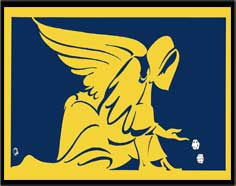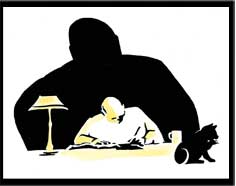Richard Walsh (pictured above left) has been chosen as a good example of the criminality widespread in outlaw motorcycle gangs. However, many others could have been selected, as the gangs have an extensive history of crime and no particular hierarchy. Powerful members involved in criminal activity tend to come and go over fairly short periods, just as they do everywhere in the drug trade. Those that survive do so because they have not been convicted, so they cannot be mentioned here for legal reasons.
Walsh was the sergeant-at-arms of the Newcastle chapter of the Nomads, but supplied drugs to Sydney and was closely connected with bikies here. He received the longest jail sentence ever given for a non-importation drug offence in Australia.
In the late 1990s he was purchasing several pounds of methylamphetamine every few weeks from Todd Little (pictured above right), president of the Gold Coast Nomads chapter and an excellent “cook” of the illegal drug. Walsh sold the drugs to Nomads on the north coast, Newcastle and Sydney, who used club hangers-on to retail it for them. Walsh’s de facto, a woman we will call Julie Clarke, also ran a group of dealers in Newcastle. He thus sat at the centre of a coastal network, but isolated himself from the most dangerous aspect of the trade – selling the drug on the street.
In 2000 the risk-averse Walsh started using a small time dealer we will call Peter Bennett to travel north to collect the drugs from Tod Little. But Bennett was poorly treated by the Nomads and went to gaol for a short period as a result. By March 2001 he had stopped doing the drug run and decided to become a police informer, his usefulness enhanced by the fact his wife was nanny for Walsh and Clarke’s children.
Thanks to this rare access to information from close to the heart of a major bikie drug operation, police were able to arrest and charge Walsh, Little, and 41 other people, including 14 Nomads. They were assisted by the fact Julie Clarke rolled in return for indemnity. Police found one of the biggest meth labs in Australia at Murwillumbah, 74 firearms including a Bren gun and weapons stolen from the military, and $1.5 million of stolen vehicles and heavy equipment, some of it used by Walsh in his legitimate concreting business. Assets to the same value were seized under proceeds of crime legislation.
Following the arrests, some of the Nomads still at large hired a private investigator to find the home addresses of detectives involved in the investigation, which was called Strike Force Sibret. They also raided a pub where the police were known to drink, closing off both ends of the street beforehand. Fortunately the police were not there at the time.
This action by bikies symbolises an important change in the relationship between police and organised criminals by the end of the 1990s. Thanks to the police royal commission and changes following it, the corruption described over most of this series had largely ceased to exist within the NSW Police Force.
Despite the Nomads’ efforts at intimidation, the prosecutions were successful, and Walsh received a sentence of 32 years, while Todd Little got 24 years. Nomads in Sydney were allegedly not happy with the level of support Walsh received in prison from his fellow club members still at large. In September 2004, about 35 Nomads from the city, including Hassan “Sam” Ibrahim, allegedly rode up to the Newcastle club house and attacked local members, kneecapping two. Ibrahim and others were put on trial and found not guilty.
According to police, at July 2010 there were 1,630 members of outlaw motorcycle gangs in New South Wales, in some 20 clubs, most of which had multiple chapters containing between 10 and 20 members. Most of the clubs are involved in crime, especially the amphetamine trade. They make effective criminal gangs because of their high level of organisation and members’ loyalty to each other and code of silence, and their preparedness to use extreme violence.
Not only have many bikies become criminals, many criminals have become bikies because of the usefulness of the gang structure to their endeavours. The most obvious example of this was the formation in 2007 of Notorious, a bikie gang without bikes.
Another strength of many bikie gangs is that most are national and even international organisations, giving them access to a wide range of drugs (or precursor chemicals), advice, and help in laundering money. It was symbolic that the clash between Hells Angels and Commanchero in March 2009 occurred not in a hotel carpark, as was the case at the notorious Milperra fight of 1984, but at Sydney Airport. Ten Commanchero were charged with murder and three Hells Angels with affray as a result.
The Nomads are a purely Australian phenomenon, and Richard Walsh’s operation, despite its success, was fairly crude. His massive cash profits were not laundered or invested in property and shares, but blown on flash vehicles and expensive domestic holidays, or stashed in boxes at home.
Another feature of contemporary bikie gangs, symbolised by Hassan Ibrahim’s involvement in the above story, is the heavy participation of ethnic members, especially Lebanese. This is typical of the changing face of organised crime, where old ethnic barriers have broken down and criminals are increasingly prepared to work with anyone else in pursuit of business opportunities. Another example was the wide ethnic mix of those accused in March 2011 in Melbourne of the importation of 15 million tabs of ecstasy. Organised crime is reflecting changing patterns of association found generally in modern multiracial Australia and its globalised business environment.
MAIN SOURCES: articles by Michael Duffy in the Sydney Morning Herald. The names Julie Clarke and Peter and Wendy Bennetts are false, to conceal the identities of the people referred to.








You must be logged in to post a comment.